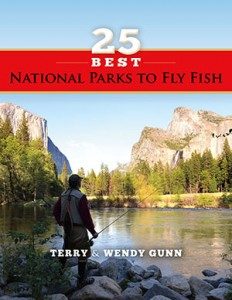Fly Fishing National Parks East to West
Stonefly Press has announced the release of the “25 Best National Parks to Fly Fish,” a where-to-go, how-to-get-there, do-it-yourself manual on fly-fishing America’s National Parks, authored by Terry and Wendy Gunn and Bennett Mintz.
Read more in the press release below.
Fly Fishing National Parks East to West
From Stoneflypress:

The nation’s first where-to-go, how-to-get-there, do-it-yourself manual on fly-fishing America’s National Parks is now available from Stonefly Press, announced publisher Robert Clouse.
The book – “25 Best National Parks to Fly Fish” – was researched, written, and edited by Terry and Wendy Gunn and Bennett Mintz. Individual park chapters were written by guides, fly shop owners and outfitters who provide services to each of the parks and nearby waters from Acadia in Maine to Katmai in Alaska.
The book’s foreword was written by Jonathan B. Jarvis, Director of the National Park Service.
Each park chapter contains driving directions, entry and access information, fish species, recommended tackle, fly patterns, seasons and mile markers for river and lake entry along with detailed maps and photos. Accompanying each chapter is a “sidebar” of travel information including highways, airports nearest the park, fly shops, campgrounds, hotels, restaurants, lodges, outfitters, must-see attractions and nearby emergency medical services.
Of America’s 57 National Parks, 29 have some degree of fresh or saltwater fly fishing. Twenty-five of the parks are covered in full detail. Four parks – Dry Tortugas, 70 miles west of Key West., Fla.; Isle Royale, on Isle Royale and adjacent islands in Lake Superior; Voyageurs, on the U.S.-Canadian border in Minn.; and Wrangell-St. Elias, in remote Alaska – are discussed to a lesser degree because of their limited access.
“25 Best National Parks to Fly Fish” is organized as a foundation for the ultimate “bucket-list” fly fishing road trip from the Northeast through the Shenandoah, into the South and eventually out West so that readers can literally turn the page and arrive at the next National Park with the information to have an enjoyable and productive fishing trip and visit to the park.
The book recognizes that there are miles and miles of notable surrounding waters – some just as good, some better – than the park itself. So “park waters” include nearby communities, forest lands and other notable fishing opportunities.
“Fly-fishing in many parks is a longtime American tradition; but there are National Parks with outstanding fishing that are largely ignored by anglers and more renowned for river-running, back-packing, sight-seeing, rock climbing, animal viewing or photography,” said Clouse.
He cited Grand Canyon, Congaree, Capitol Reef, Great Basin and Acadia national parks as examples of venues with severely underutilized fly-fishing opportunities.
While Grand Canyon hosts some 5-million visitors annually, few venture below the sight-seeing rim; yet dedicated fly-fishers catch trout throughout. Rainbow trout predominate, but browns are caught throughout the system and can be found in higher densities in particular areas … the majority of the catch ranging from 12- to 16-inches.
In South Carolina, Congaree National Park, near Columbia, boasts swamp-like conditions with a variety of fish. The Congaree River flows easterly to form the southern boundary of the park with large numbers of small and largemouth bass. In the spring, stripers up to 40 pounds migrate to spawn in the upper stretched of the Congaree River and then move into the Saluda River for the summer.
Maine’s Acadia National Park, experiencing more than 2,500,000 visitors annually, is home to native eastern brook trout, introduced lake trout – known locally as togue – landlocked (Atlantic) salmon, brown trout, and smallmouth bass. Saltwater fish species include bluefish, mackerel and striped bass. There are 22 lakes or ponds in Acadia, most managed as coldwater fisheries.
Each park consists of a single chapter with the exception of Yellowstone. Because of its size and number of fly-fishable waters extending beyond the park boundaries, Yellowstone Park is divided into four chapters. Yellowstone chapter authors are Bob Jacklin, Walter Wiese, Bruce Staples and Tim Wade. Adjacent Grand Teton National Park, written by Scott Sanchez, is a separate chapter.
Other park authors include Bob Mallard, Harry Murray, Pat Ford, Steve Schweitzer, Pat and Carol Oglesby, Shawn Saunders, Will Jordan, Jimmie Morales, Andrew Maurer, Scott Willison and Dave Steinbaugh.
The book is priced at $32.95.
For additional information or to purchase the book, contact Stonefly Press at www.stoneflypress.com; fax (877-609-3814); email [email protected].
New Fly Fishing Books
New Fly Fishing Books











